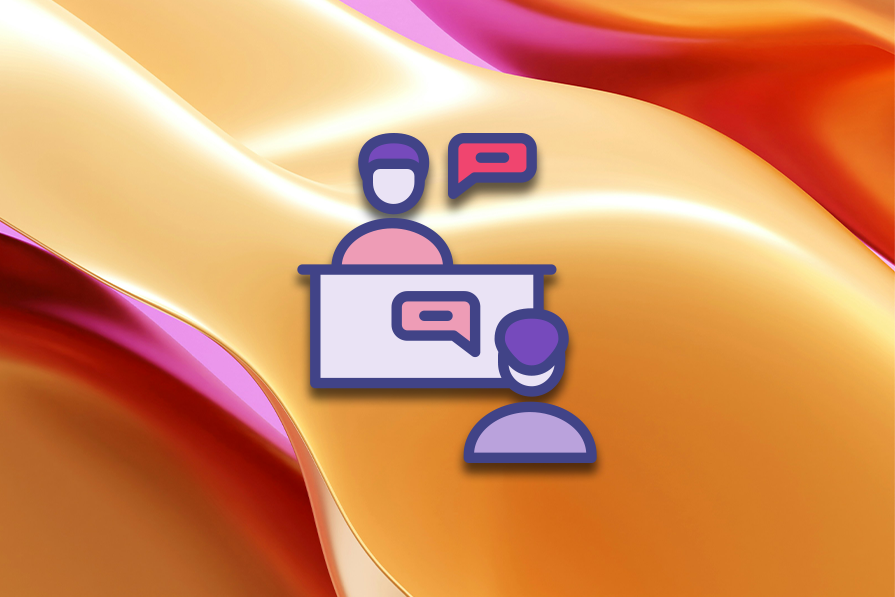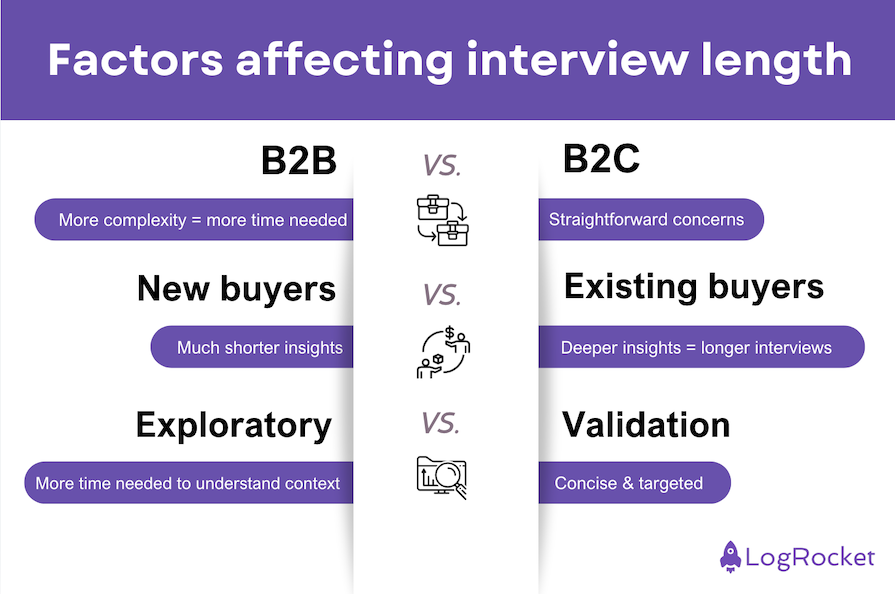Buyer persona interviews are essential for product development, providing valuable insights into your target audience and helping you validate essential hypotheses.

Well, assuming you time them right. Make your buyer persona interviews too short, and you’ll miss out on discoveries. Make them too long, and the quality of insights will decrease significantly, as will your budget.
It’s important that you find the right length of time to extract the best possible insights. Factors such as the type of interview and the customers you interview play a crucial role.
For example, an exploratory interview will require significantly more time to understand the broader context than a validation interview that seeks to confirm existing assumptions. Complex B2B products are harder to explain than most B2C products.
It’s also significantly easier to talk to existing customers than to new customers since you don’t have to establish context or build rapport. Misalign, and you might end up with a wasteful interview that either doesn’t capture all necessary insights, or uses more resources than needed.
This article helps you consider everything you need to find the perfect interview length.
Factors affecting interview length
Let’s take a closer look at what goes into deciding how long your interview should be:

B2B vs. B2C
B2B interviews typically require more time due to the complexity of products and services. B2B products handle critical use cases and customized aspects that may not exist in B2C products, which tend to have more straightforward concerns.
For example, a B2B software company might need a longer interview to understand the technical needs and workflows of a potential client, compared to a B2C clothing retailer who might be able to get the necessary information in a shorter conversation.
Existing buyers vs. new buyers
Existing customers are more familiar with your product and can offer deeper insights. Having already bought the product, these buyers are also more likely to be invested in product improvements.
Consider having longer interviews with existing customers to explore their experiences, feedback, and potential improvements.
Exploratory interviews vs. validation interviews
Always keep in mind the type of insight you’re seeking. Validation interviews focusing on confirming existing assumptions that you’ve formulated can be shorter and more targeted.
On the other hand, exploratory interviews require more time to understand the broader context and uncover hidden needs.
Keep these categories in mind as you plan ahead. If you already have an assumption you’d like to validate, you can have a short interview focused purely on that.
On the other hand, if you’re just starting to explore the needs and characteristics of the persona, you’ll need to invest more time to understand the broader context.
The importance of incentivization
If you want buyers to give you their best, you must incentivize them. Offering incentives, such as gift cards, discounts, or early access to new features, can encourage longer and more engaged interviews, especially for exploratory sessions.
It’s difficult to find someone who’ll lend you an hour of their time for no reward. The bigger the incentive, the longer — and more insightful — the interview can be.
How to determine interview length
Given all the factors influencing the perfect length of a buyer persona interview, it’s hard to give a one-size-fits-all solution.
More great articles from LogRocket:
- How to implement issue management to improve your product
- 8 ways to reduce cycle time and build a better product
- What is a PERT chart and how to make one
- Discover how to use behavioral analytics to create a great product experience
- Explore six tried and true product management frameworks you should know
- Advisory boards aren’t just for executives. Join LogRocket’s Content Advisory Board. You’ll help inform the type of content we create and get access to exclusive meetups, social accreditation, and swag.
As a rule of thumb, the manageable extremes are between five minutes to an hour. You read that right: five minutes.
Although it might sound impossible to get insights in five minutes, there are some cases in which it does make sense. For example, you can tack on a quick interview segment to your sales call or even your customer support inquiries. Adding a few extra questions to existing flows can help you get insights without actually scheduling a dedicated interview.
On the other hand, going beyond 60 minutes means that people will zone out. As people get tired, the quality of their insights diminish. Squeezing in those extra minutes doesn’t guarantee new discoveries, but it does guarantee more time and energy spent.
As a starting point, here are my high-level guidelines for the length of an interview:
- 5–10 minutes — This works best for quick validation interviews added to another customer touchpoint (e.g., a sales call)
- 10–30 minutes — Ideal for most validation interviews where you have specific questions in mind. An incentive is optional
- 30–45 minutes — Most exploratory interviews benefit from this timeframe. An incentive is a must-have
- 45–60 minutes — Deep dives into complex B2B explorations require this extended time for detailed discussions about technical needs, workflows, and business challenges
Structuring your interview
Though every interview may differ in length, most are similarly structured. I’ll walk you through the two interview structures I recommend the most.
Story-based interviews
Encourage the interviewee to tell a story related to your product or service. Ask them to describe a specific experience, such as their last purchase or how they solved a particular problem.
If you’re exploring how a person buys shoes, you could prompt them by saying something along the lines of, “Tell me about the last time you purchased a new pair of shoes.”
Based on the interviewee’s response, you can follow up on specific story fragments, digging deeper into relevant insights. Stories are much more effective in unearthing real sentiments than a rapid-fire sequence of questions and answers.
Let the client tell the story. Not only does this process reveal answers to questions you wouldn’t have thought of, it also prevents the interview from feeling like a police interrogation.
To execute this interview format, follow these steps:
- Give context — Start by outlining what the interview is about and the type of insight you are looking for. The better you frame the interview at the beginning, the higher the chance the buyer will tell you things you care about
- Story prompt — Ask the person to tell you a specific story about actions related to your product that they carried out in the past. Encourage them to go into as much detail as possible
- Follow-up questions — Dig deeper into the parts that most sparked your interest to get more insight. If there are unrelated questions you would love to hear answered, you can add them in at the very end
- Wrapping up — Thank the person for their time. Remember to instruct them on incentive collection, if an incentive exists. If the conversation was especially insightful, consider inviting them to other studies you are conducting.
Experience-based interviews
Another approach to buyer interviews is to give them something to play with (usually a prototype or a minimum viable product) and ask questions on the go.
This method is especially useful for validation interviews — it’s easier to confirm a particular assumption if the interviewee can experience the product firsthand.
The experience-based interview process:
- Give context — Once again, outline what the interview is about and the type of insight you’re looking for. This step remains the same as in the story-based method. The better you frame your interview, the better insights you’ll get
- Give a task — Much like a moderated test, give the buyer a task and a tool to complete the task. Ask them to narrate what they are thinking and feeling
- Ask questions during the experience — You might become curious as to why the interviewee did something in a particular way, or notice them struggling. Don’t wait until the end of the task. Instead, ask your questions in the moment. You’ll get more honest feedback
- Ask closing questions — As you wrap up the experience, you can ask a few general questions, such as how the experience went overall or what they would want to improve. You might get interesting holistic insights
- Wrapping up — If there is an incentive, instruct the client on collection. Disclose the next steps, as well as how to stay in touch for further research
Remember, those are just guidelines; you should tailor your interviews to your needs.
Time management
How do you manage time during the interview? The answer is simple — you don’t.
While these time guidelines exist for a reason, it’s important to be flexible.
Some interviewees will be concise, sometimes overly so. To combat this, you can always prompt for more details.
Others will talk excessively. But if you interrupt them, you risk missing out on insights you didn’t even consider. Only intervene if the interviewee goes heavily off track.
Don’t force a specific timeframe. Be adaptable and adjust your approach based on the flow of the conversation.
Running short on time? Prioritize your main questions and skip the less relevant ones. If there’s nothing to cut, you can always ask if the interviewee is okay with staying a couple of minutes longer.
In my last round of buyer interviews, I allotted 45 minutes to each person. Some interviews lasted almost an hour. Others lasted just twenty minutes.
At the end of the day, your buyer person interviews are conversations with real people. To navigate these conversations with nuance, understand that you can’t categorize all people into one box.
Key takeaways
Buyer persona interviews are a great tool for understanding buyer motivation, pain points, needs, and objections. Aim to conduct them regularly — monthly, or, ideally, weekly. Try to incorporate elements of these interviews into your customer support and sales processes.
Timing will vary, but 30-45 minutes is generally a good starting point. Some interviews will run shorter or longer, and that’s perfectly normal. Remember not to fight the timeframe — work within what you’ve got for a better result.